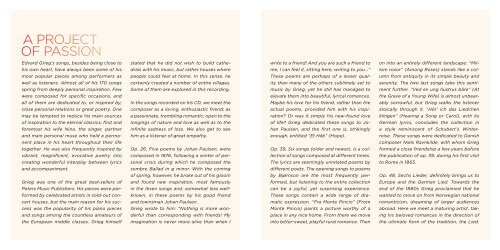Sie wollen auch ein ePaper? Erhöhen Sie die Reichweite Ihrer Titel.
YUMPU macht aus Druck-PDFs automatisch weboptimierte ePaper, die Google liebt.
A PRoject<br />
of PAssion<br />
edvard Grieg’s songs, besides being close to<br />
his own heart, have always been some of his<br />
most popular pieces among performers as<br />
well as listeners. almost all of his 170 songs<br />
spring from deeply personal inspiration. Few<br />
were composed for specific occasions, and<br />
all of them are dedicated to, or inspired by,<br />
close personal relations or great poetry. One<br />
may be tempted to reduce his main sources<br />
of inspiration to the eternal classics; first and<br />
foremost his wife nina, the singer, partner<br />
and main personal muse who held a permanent<br />
place in his heart throughout their life<br />
together. He was also frequently inspired by<br />
vibrant, magnificent, evocative poetry into<br />
creating wonderful interplay between lyrics<br />
and accompaniment.<br />
Grieg was one of the great best-sellers of<br />
Peters Music Publishers. His pieces were performed<br />
by celebrated artists in sold-out concert<br />
houses, but the main reason for his success<br />
was the popularity of his piano pieces<br />
and songs among the countless amateurs of<br />
the european middle classes. Grieg himself<br />
stated that he did not wish to build cathedrals<br />
with his music, but rather houses where<br />
people could feel at home. in this sense, he<br />
certainly created a number of entire villages.<br />
Some of them are explored in this recording.<br />
in the songs recorded on his CD, we meet the<br />
composer as a loving, enthusiastic friend; as<br />
a passionate, trembling romantic; open to the<br />
longings of nature and love as well as to the<br />
infinite sadness of loss. We also get to see<br />
him as a listener of great empathy.<br />
Op. 26, Five poems by Johan Paulsen, were<br />
composed in 1876, following a winter of personal<br />
crisis during which he composed the<br />
sombre Ballad in g minor. With the coming<br />
of spring, however, he broke out of his gloom<br />
and found new inspiration, most famously<br />
in the ibsen songs and, somewhat less wellknown,<br />
in these poems by his good friend<br />
and townsman Johan Paulsen.<br />
Grieg wrote to him: “nothing is more wonderful<br />
than corresponding with friends! My<br />
imagination is never more alive than when i<br />
write to a friend! and you are such a friend to<br />
me, i can feel it, sitting here, writing to you...”<br />
these poems are perhaps of a lesser quality<br />
than many of the others sublimely set to<br />
music by Grieg, yet he still has managed to<br />
elevate them into beautiful, lyrical romances.<br />
Maybe his love for his friend, rather than the<br />
actual poems, provided him with his inspiration?<br />
Or was it simply his new-found love<br />
of life? Grieg dedicated these songs to Johan<br />
Paulsen, and the first one is, strikingly<br />
enough, entitled “et Håb” (Hope).<br />
Op. 39, Six songs (older and newer), is a collection<br />
of songs composed at different times.<br />
the lyrics are seemingly unrelated poems by<br />
different poets. the opening songs to poems<br />
by Bjørnson are the most frequently performed,<br />
but listening to the entire collection<br />
can be a joyful, yet surprising experience.<br />
these songs contain a wide range of dramatic<br />
expression. “Fra Monte Pincio” (From<br />
Monte Pincio) paints a picture worthy of a<br />
place in any nice home. From there we move<br />
into bitter-sweet, playful rural romance. then<br />
on into an entirely different landscape: “Millom<br />
rosor” (among roses) stands like a column<br />
from antiquity in its simple beauty and<br />
serenity. the two last songs take this sentiment<br />
further. “Ved en ung hustrus båre” (at<br />
the Grave of a Young Wife) is almost unbearably<br />
sorrowful, but Grieg walks the listener<br />
stoically through it. “Hör’ ich das Liedchen<br />
klingen” (Hearing a Song or Carol), with its<br />
German lyrics, concludes the collection in<br />
a style reminiscent of Schubert’s Winterreise.<br />
these songs were dedicated to Danish<br />
composer niels ravnkilde, with whom Grieg<br />
formed a close friendship a few years before<br />
the publication of op. 39, during his first visit<br />
to rome in 1865.<br />
Op. 48, Sechs Lieder, definitely brings us to<br />
europe and the German Lied. towards the<br />
end of the 1880s Grieg proclaimed that he<br />
wanted to move on from norwegian national<br />
romanticism, dreaming of larger audiences<br />
abroad. Here we meet a maturing artist, taking<br />
his beloved romances in the direction of<br />
the ultimate form of the tradition, the Lied.








